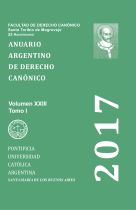Please use this identifier to cite or link to this item:
https://repositorio.uca.edu.ar/handle/123456789/5506| Título: | La scelta della forma processuale brevior nel can. 1676, 2 : criteri e prassi concreta | Autor: | Bianchi, Paolo | Palabras clave: | DERECHO PROCESAL CANONICO; PROCESO BREVE; OBISPOS; MATRIMONIO; NULIDAD MATRIMONIAL | Fecha de publicación: | 2017 | Editorial: | Universidad Católica Argentina. Facultad de Derecho Canónico | Cita: | Bianchi, P. (2017). La scelta della forma processuale brevior nel can. 1676, 2 : criteri e prassi concreta [en línea]. Anuario Argentino de Derecho Canónico, 23(1). Disponible en: https://repositorio.uca.edu.ar/handle/123456789/5506 | Resumen: | Resumen: La reforma procesal del proceso declarativo de nulidad posee diversas novedades canónicas, siendo la más significativa el proceso brevior delante del Obispo. Siendo el Vicario judicial quien determina la forma procesal a seguir en cada causa, es un tema actual que lleva poco tiempo de praxis judicial y que sin duda requiere del analisis en la aplicación concreta por parte de los tribunales. En este caso, considerando algunas causas del Tribunale Regionale Lombardo di Milano. Abstract: The procedural modification of nullity declaratory judgments has several canon novelties. The most meaningful of these is the shorter procedure before the Bishop. Since it is the Judicial Vicar who decides the procedural way en each lawsuit, it is a current issue that carries a short time in the judicial praxis, and that needs the analysis of the specific implementation in by the Courts. Some lawsuits of the Regional Court Lombardo from Milan are analyzed in this opoprtunity. |
URI: | https://repositorio.uca.edu.ar/handle/123456789/5506 | ISSN: | 0328-5049 | Disciplina: | DERECHO CANONICO | Derechos: | Acceso Abierto | Fuente: | Anuario Argentino de Derecho Canónico, 23 (1), 2017 ISSN 0328-5049 |
| Appears in Collections: | AADC - 2017 Vol. XXIII Tomo I |
Files in This Item:
| File | Description | Size | Format | |
|---|---|---|---|---|
| scelta-forma-processuale-brevior-bianchi.pdf | 278,91 kB | Adobe PDF |  View/Open |
Page view(s)
152
checked on Apr 30, 2024
Download(s)
533
checked on Apr 30, 2024
Google ScholarTM
Check
This item is licensed under a Creative Commons License

